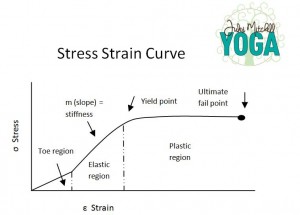Poor stiffness.
The problem is that when we use stiffness in a casual manner, it doesn’t match up with the mechanical definition of stiffness. This causes confusion and we end up thinking that the opposite of stiffness is flexibility (defined here as increased range of motion or ROM). It’s not. The opposite is more like compliance. But we will have to investigate that concept more in my next post, Stiffness: Part 2.
For today, let’s just get familiar with the term stiffness as a mechanical property.
It’s always good to start with a definition.
Dictionary.com gives several meanings. Let’s look at the two most relevant to our conversation.
This one is the way we use “stiff” colloquially: not supple; moving with difficulty, as from cold, age, exhaustion, or injury.
But this is the one that most represents the way engineers (and biomechanists) use the word: rigid or firm; difficult or impossible to bend or flex: a stiff collar.
If we think of stiffness as “not supple” and “moving with difficulty,” then yoga, pilates, stretching, etc. is the natural remedy. But when we use yoga, pilates, stretching, etc. to remedy stiffness as “rigid or firm,” we run into trouble.
See the difference yet? Don’t worry, let me explain.
We actually want our connective tissues to be stiff. Yes, that is correct. Stiff tendons are desirable. So are stiff ligaments, but I will cover those in Stiffness: Part 2.
In mechanical terms, stiffness is a measure of how much load a material (steel, for example) can take before it deforms. In biomechanical terms, stiffness is a measure of how much load a tissue (tendon, for example) can take before it deforms. Essentially, stiffness represents how strong and resilient a material is under stress.
On a side note, if you are unfamiliar with terms like load/stress and deformation/strain, you may want to take a minute and review my first blog post on the subject of tissue mechanics: http://www.julesmitchell.com/tissue-mechanics-connective-tissues/
Are you back?
So how does mechanical stiffness show up in our bodies? Hint: It isn’t about aches or pain.
We can all agree that tendons connect muscle to bone so that we can move our skeletons. If you keep your shoulder fixed and concentrically contract your biceps (shorten the muscle length), the force you generate transmits through the distal biceps tendons to the radius and ulna (forearm bones) and flexes your elbow.
Now imagine that tendon complex is not stiff, meaning it deforms very easily. The tendon would just get longer and longer, absorbing the distance left behind by the shortened muscle, and the bone would not move. You would have to generate more force by contracting the muscle even more until finally, the tendon would eventually stop deforming and the bone would move. That’s a lot of effort to move. I’m exhausted just writing about it.
To use an analogy, it would be like feverishly pumping on the gas pedal in your car and not going anywhere. Like being stuck in the mud. Which I know nothing about since I live in Los Angeles and we don’t have mud. Only concrete.
The point is, we wouldn’t design our cars that way. It would be a waste of fuel (like calories in the human body). Cars are designed so the accelerator efficiently fuels the engine and the car readily displaces (changes position). That sounds good. I’d buy that car.
So if a tendon is stiff (meaning it can take a lot of load without deforming) then the muscle force will be readily transmitted to the bone and the movement will be swift and efficient. That sounds good. I’d take that body.
So how do you increase stiffness in your tendons? You load them by doing muscle work. Remember that biological tissues adapt to the demands place on them. Muscle contractions load the tendon because it is the tendons job to transmit muscle force. When you load your muscles at the gym, they get stronger, but the tendons also get stronger so they can keep up with the muscle and continue to do their job.
Here is the stress strain curve again. Notice the slope of the curve in the elastic region is labeled stiffness. To generalize, that means the more stiff your tendon is, the more readily it will also return to its resting length. Sort of. The term for that is elastic modulus, and it’s not exactly the same as stiffness – but that road gets complicated very fast. All you need to get for today is that they both good.
Stiffness and elasticity are both desirable, however, they both decline with age. It figures. But you can hold off the process by…
…wait for it…
…MUSCLE WORK.¹
So whether you are young and stiff (go stiffness) or old and un-stiff, don’t forget your daily dose of muscle work.
Stiff doesn’t seem so miserable any more, does it?
P.S. Notice that the stiffness and elasticity of a tissue are not the same as range. Range is about how much strain the tissue can withstand. But that’s content for a separate post. BTW, if you decide to stick with me, get friendly with that Stress Strain Curve. I will refer to it often.
1 Reeves, N. D. (2006). Adaptation of the tendon to mechanical usage. Journal of Musculoskeletal & Neuronal Interactions, 6(2), 174–180. Retrieved from http://www.ncbi.nlm.nih.gov/pubmed/16849829
Extend Your Learning: Online Education With Jules
Yoga Biomechanics Livestream
My flagship 3-day livestream course is for teachers who have an insatiable curiosity about human movement and kinesiology, are eager to know what the research says about yoga, and are open to accepting that alignment rules aren’t always accurate. Includes 30 days of access to the livestream replay and slides. 18 CEUs. Learn more >


